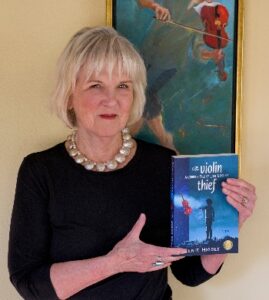Interview by Danielle Largesse
Today we have local author Genie Higbee, author of THE VIOLIN THIEF: A Curious Tale of Lost & Found. She is multi-talented in both literature and art which shows in her book that ties it all together including the additive of music. Her many influences include impressionism, tonalism, realism, art deco, bravura, calligraphy, folk art, dance, music, and many more.
Let’s get started!
How long have you lived in the Northwest? What initially attracted you to this place? Has living in this area influenced your writing?
I was introduced in my youth to the land of big sky, forest and lake by my Montana-born parents; we vacationed here in order to spend time with extended family. In 2004, my husband and I chose to join my elderly parents in this locale with the added intrigue of exploring the Pacific Northwest for ourselves.
My writing is aided by the long quiet winters in particular, and the beauty of nature in general, but I have always written, anywhere, anytime, just because. Poetry and short stories were the bulk of my work until 2000 when I began to explore the novel and screenplay forms.
Can you tell me a little bit about your book, THE VIOLIN THIEF: A Curious Tale of Lost & Found? What inspired you to write the story?
Here’s the pitch: 1941 Adirondacks. When Douglas Tryzyna deciphers the voice of an incognito violin, he realizes they are destined to spark goodwill with music. An avid student, he gets tangled with a violin professor. The man, a German émigré, is dead-set on showcasing his own blasé son as a virtuoso—Douglas will be the ideal spur. The peers’ relationship yo-yos between brotherhood and rivalry, complicated by a piano-playing sweetheart. As clashing desires explode into obsessions, a centuries-old rivalry is also playing out. Lyrical. Startling. Exploring complexities of the heart and the grace of music.
Curious thing, inspiration for a novel. It can drop in turn-key completely, or it can wash over you like a series of waves. This novel was more the latter.
I was at the start of a novel, working title, Isola Lost, about an idealistic art student who had burned her bridges at University. She’s regretfully headed home. Meeting a violinist on the train, she accepts a questionable proposal from the guy in exchange for an adventure. However, the male character spoke to me. He convinced me to write his story first, saying, I really didn’t know him or his intentions! I began his tale with a simple plot while at the same time I was seeking appraisal for my late father’s violin (hoping it would sell with the proceeds benefiting my mother). The experience of taking a rare violin to an international auction skyrocketed and the simple plot I had imagined for man’s story became layered with the serendipity of history I chanced upon.
As an author who has many interests such as art and writing, what is your favorite and why?
My earliest memory of writing included drawing. 1st grade, perhaps, no more than a few words I’m sure, a story about a carrot that didn’t want to be planted nose-down in the muddy garden, didn’t fancy being eaten, and so it pulled itself up and ran away into the forest. Also memorable, my school teachers predicted I’d grow up to be an author/illustrator. The idea bloomed and I became aware, filled with wonderment, for what real authors could do with story and characters. Art was my major at University with a minor in Literature. It seems, writing fuels-informs my drawing and painting—vice-versa is true. I hope never to face choosing only one.
Is there a particular author you admire and why?
So many authors to admire!! Currently I’m enamored with Olga Tokarczuk, polish, with a Nobel Prize in Literature. Add to that Ruth Ozeki, and Kazuo Ishiguro. The commonality is that each author is inventive, original, with amazing power to intrigue a reader.
What do you want readers to take away from your book?
Writing for me is an exploration of life: I want to share those explorations, ones that might bring readers together emotionally and intellectually. For example, the main character in THE VIOLIN THIEF, Douglas Tryzyna, has an additional sense that infuses him with endurance…despite the hardships that others, and ironically, he himself, create. (Reminds me of: Hans Christian Andersen’s, The Steadfast Tin Soldier.) My hope is that a reader gathers understanding, compassion or strength, or simply finds a new world of characters to befriend.
What is next for you?
ART: I have two series of oil paintings in progress each destined for a welcoming Gallery.
Kids Being Kids, bright graphic works.
Here & There, unexpected, mysterious, through-the-window pairings of still life and landscape.
WRITING: Two sequels—TO LOVE A THIEF and TO SAVE A THIEF, both in progress.
How can readers find you?
Visit Website: www.geniehigbee-art.com
Browse Gallery Shop
Insider goodies about the Novels
Borrow a copy from The Library
Purchase a copy for yourself
Read Genie’s Blog
Connect on Instagram
Any parting thoughts?
Thank you for this interview opportunity. I’m grateful to THE LIBRARY for including me in the introduction of authors to the community. We authors tend to be tucked away dreaming up scenarios or pecking out paragraphs. And gosh, what would a book be without a reader?

